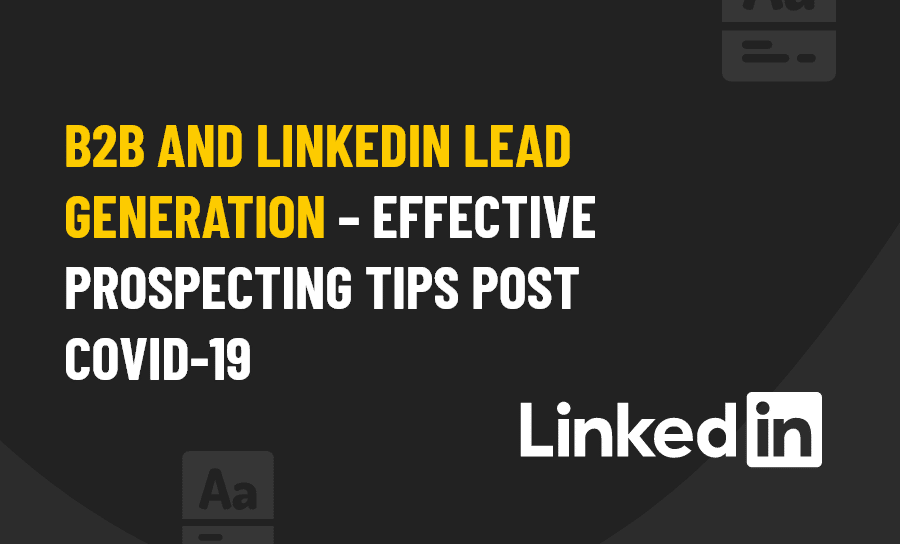In terms of lead generation and closing new business in the 21st century, LinkedIn is a hot spot. Or it can be. It allows you the chance to connect with potential new clients or customers in a way you never quite could before, on a one-on-one basis in a more social environment – as business-oriented as LinkedIn is, it’s still a social network – and has more personalized, real-time conversations with your leads. As a LinkedIn user, you will be able to connect with a potential lead on a more personal level.
It is especially effective when it comes to B2B lead generation and right now when lots of decision-makers are working remotely from home rather than at the office due to COVID-19. As people are now scattered all over the place, and may not even be ‘at home’, LinkedIn probably offers a far better chance to make a successful ‘cold connect’ than attempting to reach people via their office phone numbers.
More people ARE using LinkedIn in this post-COVID-19 world as a way not just to stay in contact with their colleagues and peers but to keep up with news and developments in their niche. Many who once only checked the platform very occasionally are now logging in a lot, increasing the chances that your B2B lead generation campaign will be successful.
When it comes to finding leads on LinkedIn there are a number of really effective ways to go about it, and we’ve covered many of those in the past. With time and effort – and maybe even some help from a LinkedIn B2B lead generation pro – you can find prospects within almost any niche that you may have never discovered any other way.
However, finding leads on LinkedIn is actually the easy part, at least when compared with the next step in the process; determining the best way to approach these leads to open a conversation without coming across as yet another high-pressure salesperson with nothing new to offer or, worse still, a creepy stalker.
Here are some tips for how to use LinkedIn cold outreach messages to generate leads and to start sales conversations.
FINDING COMMON GROUND
One of the biggest advantages LinkedIn offers as a lead generation and outreach channel is that you can find out a lot about a potential customer before ever reaching out to them.
Most people have filled out their basic profile (as with every social media platform) – location, job role, work history, educational background etc. – and even just from that you may find something in common with them to make a first cold contact friendlier and more genuine sounding. When people also add biographical and interest information, which many do, you have even more to work with.
Maybe you come from the same general geographic area. Or went to the same university. Or read some of the same books. Maybe you recently shared the same Gary Vaynerchuk article. Whatever you can find in common with your prospect use it to craft a message that is unique and targeted directly to them. At the very least they will be flattered that you took the time to read their profile enough to do that.
In terms of your prospect’s willingness to respond to your message, LinkedIn can be a big help too. People – B2B decision-makers included – do often baulk at conversing, even via messages – with someone they know nothing about.
As long as your LinkedIn profile is properly completed and optimised the targets of your LinkedIn cold outreach campaigns can easily ‘look you up’ and learn more about you, and what they learn if your LinkedIn profile is sending the right message should make them far more inclined to start a conversation. This way you are likely to get quality leads within your target audience. As a marketer, there is no better professional platform than LinkedIn.
LOOK FOR MUTUAL CONNECTIONS YOU CAN NAMEDROP TO BREAK THE ICE
Anyone who’s on LinkedIn is familiar with the ‘degrees of separation’ nature of the connections system. If you can manage to namedrop a first or even second-degree connection (provided that you at least know who they are) that can be another great way to personalize your LinkedIn cold outreach message and come across as something more than an absolute stranger sending out random messages into the LinkedIn ecosystem.
You do not have to be too obvious about this. Try something along these lines; “Hi [first name]! I noticed you and I are both connected to [name of mutual connection] and I thought I would reach out to connect with you as well. Where do you know [name of mutual connection] from, anyway?”
KEEP IT SHORT AND SWEET
LinkedIn ‘cold’ direct messaging should be approached, at least initially, in the same way as a text or a WhatsApp message. That means not sending paragraphs of text when a few concise sentences will do. And keeping things as conversational as possible.
The length of your message has a significant impact on whether the lead will reply. Your goal in your first cold LinkedIn message is to get the recipient to respond. That’s it. So keep your message short and to-the-point so your recipient actually reads it.
DON’T TRY TO SELL ANYTHING…YET
As it is in any form of cold outreach diving straight in with a heavy sales pitch is a cardinal sin. Do not be tempted to push your product or service, that will come later. For now, your goal is to make a connection and get a positive reply. That’s it. Once that connection is made you can BEGIN to make a heavier business pitch, but LinkedIn B2B lead generation is about making connections first, selling second. It can be a longer game, but one that is almost always worth ‘playing.’
GIVE THEM A GOOD REASON TO REPLY

If you received a message from a stranger on LinkedIn, you probably wouldn’t be inclined to respond unless they gave you a good reason, right? So while your initial message should focus on establishing a relationship instead of selling, you do want to include some sort of ask to keep the conversation active.
Include a question at the end of your message that will give the prospect a reason to respond. This could be a question about their experiences, interests, a mutual connection, or even their occupation or position. Ask them something that only someone in their position would know. People love being helpful, so asking a prospect for their insight or expertise on a certain topic might make them more inclined to respond. Make them think they are doing you a favour by responding and, for 90% of people, that little ego boost alone – that they are being sought out for their help – is enough to trigger a response.
And if you’re still not convinced, you can always use a lead generation tool that will automate the lead gen process, improve your lead generation strategy and ultimately increase your conversion rate!
Need help with B2B LinkedIn lead generation? We’re here for that. Give us a call today and let’s talk about what LinkedIn lead generation could do for you.
faqs
The key to generating B2B leads is to use proven techniques like cold emailing and cold calling to get the word out about your business and your brand. While you might think of cold messaging as annoying or ineffective, many business leaders rely on cold messages to make decisions about their partnerships with other businesses. It gives them a good sense of who’s most interested in their business and also allows them to speak with the representatives of the company personally.
Of course, any lead generation strategy shouldn’t consist of one communication method. That’s why it’s also important to create digital content for your brand on your website and social media pages. This will allow other businesses to find relevant information when they do more profound research on what you have to offer.
B2B prospecting is the process of identifying, contacting, and converting your entire set of leads. B2B prospecting is an essential practice in B2B lead generation, as it allows you to speed up your sales process by streamlining how you discover and convert a higher volume of leads. When B2B prospecting, you want to make sure that you’re doing in-depth research before you contact any business so you can be confident that any business you reach out to will demonstrate at least some level of interest in a partnership with you. There’s nothing that wastes more time and money than reaching out to a client who’s not interested in the product or service you have to offer.
The B2B sales process is an in-depth procedure that allows you to maintain a clear structure whenever you’re selling to a company. Here are the main steps of the process in the context of a sales call:
- Research – Make sure that you’re constantly researching the companies before you contact them so that every call or contact you make has some possibility of generating a sale.
- Gather information – Once you’ve done some research on the company, call up the business representative and ask them open-ended questions that will give you additional information on how you should make your pitch.
- Make your pitch – This is perhaps the most critical part of the process. At this stage, you’ll want to make your pitch about why you think your companies should partner together, using the information you gathered in the first two steps to your advantage.
- Closing – This is another crucial part of the process. After you make your initial pitch, the customer might have objections or questions to raise. You must answer all of their concerns and make a convincing argument as to why they should partner with your company.
- Follow-up – Follow up with the customer with an additional email that thanks them for their time and provides your entire call for reference. Keep it professional and leave a good impression on the client. Even if they disagreed right away with your sale, they might come back to your message and start a partnership in the future.





